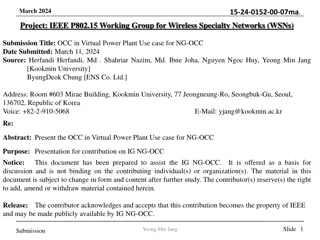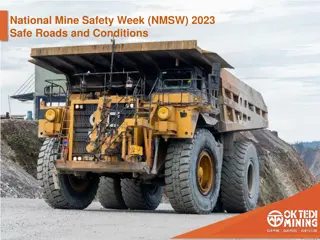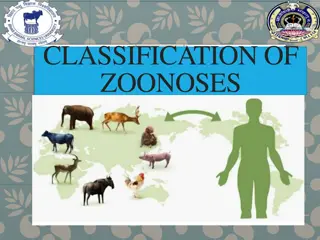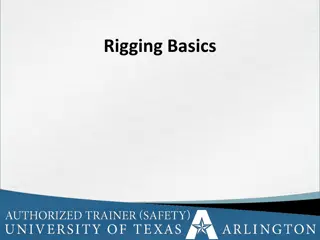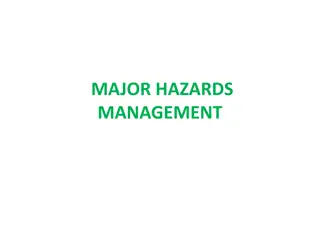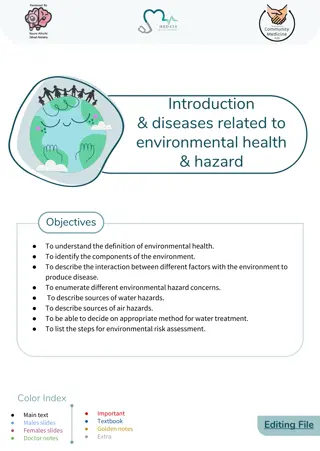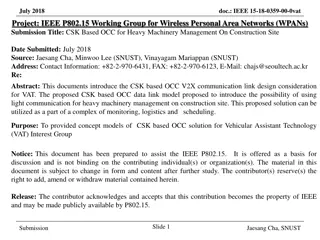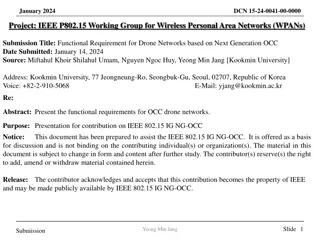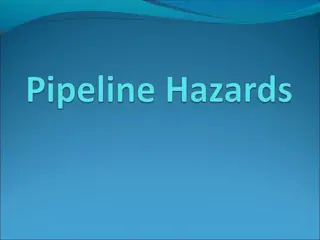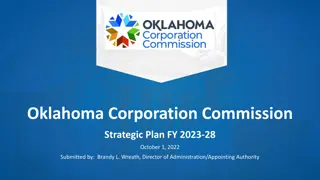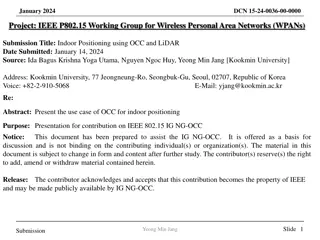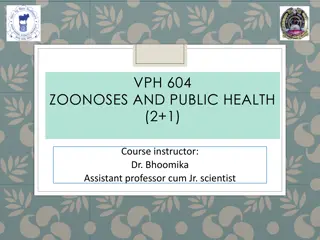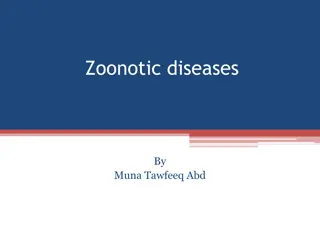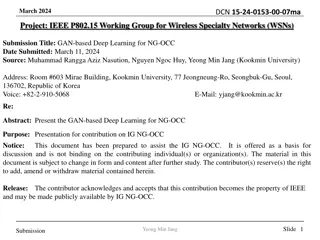
Workplace Hazards and Risks in Animal Resource Occupational Health & Safety
Discover the unique risks and comprehensive strategies for identifying, assessing, and managing workplace hazards and risks in the field of Animal Resource Occupational Health & Safety. From allergens to ergonomic challenges, learn how to promote a healthy workplace environment and ensure staff safety. Stay informed and proactive to mitigate risks effectively.
Uploaded on | 0 Views
Download Presentation

Please find below an Image/Link to download the presentation.
The content on the website is provided AS IS for your information and personal use only. It may not be sold, licensed, or shared on other websites without obtaining consent from the author. If you encounter any issues during the download, it is possible that the publisher has removed the file from their server.
You are allowed to download the files provided on this website for personal or commercial use, subject to the condition that they are used lawfully. All files are the property of their respective owners.
The content on the website is provided AS IS for your information and personal use only. It may not be sold, licensed, or shared on other websites without obtaining consent from the author.
E N D
Presentation Transcript
Animal Resource Occupational Health & Safety 2/10/22 update jw
WORKPLACE HAZARDS and RISKS Identification Awareness Risk Assessment Risk Management
The Animal Resource is a healthy workplace for all staff. Unique Risks : Allergens Ergonomics Zoonoses Bites-scratches Cage wash entrapment Sharps Experimental Hazards Biological Chemical Radioactive Seek medical guidance: Reproduction/Pregnancy Immune Status
Risk : Allergens - Animal dander and secretions, urine proteins & bedding dust Awareness: All staff contacting all animals are at risk. Clinical signs: red-itchy eyes, sneezing, wheezing, rash and difficulty breathing may progress to asthma Risk Assessment : Pre-existing allergies discussed with UHS at hire & at least annually. Highest risk: Cage preparation and dumping Aerosols - Vacuuming fur, Power washing Risk Management : Downdraft Cage Dumping Stations HEPA filtered vacuum exhaust PPE recommended by UHS
Risk : Experiment related Biological, Chemical & Radiation Hazards Awareness: laboratory animals to hazards posing risk to employees. EHS reviews use of all research protocols dosing or exposing Risk Assessment : Risk present when with working animals, their caging & waste in rooms with the REQUIRED Hazard Signage on cage cards (ABSL 1 or 2, chemical or radioactive hazards) and on doors (ABSL-2 hazards). Risk Management : Door signage clearly identifies ABSL2 hazards and PPE required to enter the room. Written Hazard Use instructions composed by EHS describe what practices are required by Animal Resource Staff when handling all hazard-dosed animals and their cages and soiled bedding are present inside all animal room. Each cage card housing a hazard dosed animal indicates the hazard.
Risk : Ergonomics Awareness: All staff lifting, bending, twisting or with repetitive motion tasks Risk Assessment : Pre-existing injuries discussed with UHS at hire & at least annually. Highest risk: Mouse cage changing, cage & waste movement to & from cage wash & dumpsters, cage manipulation in cagewash, lifting animals or bags of bedding, feed & garbage. Deskwork using PC. Risk Management : Workplace assessment, following recommendations and training by Environmental Health & Safety (EHS).
Risk : Sharps- Needles, Scalpels, Broken Glass Awareness: Hypodermic needles and scalpels may be present in surgical & procedural areas. Broken glass may be present in animal rooms using water bottles. Risk Assessment : Highest risk when working in surgical and procedural areas and their garbage bags or carcass bags or red bags or full sharps containers Risk Management : Hypodermic needles must not be recapped (unless justified and using the one-handed technique). Needles and scalpel blades must be placed in EHS approved red sharps containers. Broken glass must be placed EHS approved containers.
Risk : Animal bites or scratches. Awareness: Any animal may bite, scratch and some may kick. Risk Assessment : Highest risk when handling or near animals. Risk Management : Staff trained on species-specific handling techniques. If bitten or scratched or injured by an animal, go to UHS after informing the Animal Resource Office staff (phone or in person) who will notify your supervisor. If injury involves a macaque, follow the Monkey Bite/Scratch Protocol. While any mammal may transmit rabies, the commonly recognized rabies vector species (e.g. cats, ferrets) in the vivarium are acquired with prior immunization and not given boosters given no risk of exposure within the vivarium.
Risks: Cage Rack Washer Entrapment Awareness: Risk Assessment : Highest risk when entering, exiting, cleaning, servicing, loading or unloading a walk-in rack washer. After one cage wash worker died at another U.S. institution due to entrapment, signage, training and cage washer changes are required. Risk Management : Initial and annual training on rack washer safety. Always look inside rack washer before turning on. Know how to force rack washer doors open with your body. Know how to de-energize rack washer by pulling internal emergency cords.
Risk : Bulk Autoclave Entrapment Awareness: Training and signage next to the emergency stop button and other signage that identifies all of the safety features. Risk Assessment : Risk exists if a person closing the autoclave door does not look in the chamber when closing the door. It is not possible for the person pushing equipment into the bulk autoclave to accidentally close the door. A lock out mechanism is activated if a person must provide service inside the chamber. Risk Management : Initial and annual training on bulk autoclave safety. Always look inside the chamber before closing the door. Know how to use the emergency stop button and activate the lockout mechanism.
Risk : Zoonosis Herpes B- Cercopithecine herpesvirus Awareness: Asymptomatic in all macaques shed in saliva, ocular and reproductive tract secretions. May see NHP lip blisters & red eyes. Risk Assessment : Highest risk when bitten or scratched working with or near macaques. One human case of eye splash with reproductive tracts secretion - urine. One case with spouse sharing ointment treating a bite wound. Can be fatal in humans. Risk Management : Wear PPE when near alive or dead macaques (eye & mouth protection, gown, gloves, long pants ). No petting. Be aware of kit locations for Emergency Treatment of Bites, Scratches, Eye Splash and theoretical exposures such as needle stick or scrape by a soiled cage surface. IMMEDIATELY begin self treatment as you seek further help including visit to UHS or Emergency Dept.
Risks : Fish Zoonosis Mycobacterium marinum Awareness: Clinical signs in people include abscesses in fingers or rash on skin. Asymptomatic in most fish and potentially present in tank water. Risk Assessment : Highest risk when handling fish or contaminated water. Risk Management : Wear exam gloves when handling fish or touching tank water. Wash hands after handling animals or animal habitats. All zebrafish are acquired free of M. marinum and routinely surveyed for M. marinum.
Risk : Enteric Zoonosis Salmonella, Shigella & Campylobacter Awareness: Asymptomatic in nonhuman primates, reptiles, amphibians and birds. Clinical signs in people include abdominal pain, fever and diarrhea. Risk Assessment : Highest risk when working with nonhuman primates & reptiles and their soiled caging or substrates. Risk Management : Keep feces out of your mouth. Wear gloves when handling nonhuman primates or any surfaces they contact. Wash hands thoroughly after handling animals or soiled caging/equipment. Do not take workplace shoes or clothes home. Sanitize all surfaces containing nonhuman primates and reptiles. Both bacteria may survive on clean appearing surfaces.
Risk : Frog Zoonosis Chlamydia sp., Mycobacterium marinum, Salmonella Awareness: marinum & Salmonella in people include pneumonia, skin abscesses and diarrhea, respectively. Asymptomatic in most frogs. Clinical signs of Chlamydia sp, M. Risk Assessment : Highest risk when handling frogs or water. Risk Management : Wear exam gloves when handling frogs or touching tank water.
Risk : Zoonosis of canaries, parakeets and chickens: Chlamydia psittaci Awareness: clinical signs. Infection in people may cause fever, headache, pneumonia, or more severe systemic respiratory signs, conjunctivitis, myocarditis, hepatitis, and encephalitis. Infection in birds may be subclinical or cause a wide range of Risk Assessment : Highest risk with direct contact or aerosol exposure to exudates, secretions, or feces of psittacine birds (e.g. parakeets). Risk Management : Birds are bred in-house in a closed colony (canaries) or obtained from disease-free sources (parakeets). Wear gloves when handling parakeets or their soiled caging/equipment, and wash hands after.
Risk: Sheep Zoonosis Q Fever (Coxiella burnetii) Awareness: Asymptomatic in sheep and most people (possibly flu-like syndrome). People with heart valve defects or pregnant/immunocompromised people are most at risk of harm including miscarriage and endocarditis. Risk Assessment :Large numbers of C. burnetii are shed from infected animals during birthing in the amniotic fluid and placenta. Handling the uterus, placenta, mammary glands, amniotic fluids, milk, and the newborns carry risk of exposure. Risk Management : Training and specific PPE, sanitation and transport practices required for at risk staff contacting potentially, shedding or contaminated timed pregnant or pre-weanling sheep and their tissues, milk or placenta. .
THANK YOU for helping us all promote a safe and healthy workplace.

